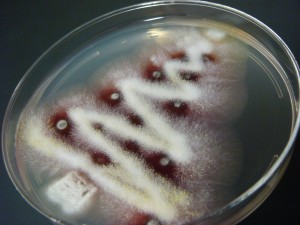 Hosts: Vincent Racaniello, Dickson Despommier, Rich Condit, and Alan Dove
Hosts: Vincent Racaniello, Dickson Despommier, Rich Condit, and Alan Dove
Vincent, Dickson, Rich, and Alan review the 100 year old finding by Peyton Rous of a transmissible sarcoma of chickens, a discovery that ushered in the era of tumor virology.
Click the arrow above to play, or right-click to download TWiV 163 (61 MB .mp3, 102 minutes).
Subscribe (free): iTunes, RSS, email
Links for this episode:
- Transmissible sarcoma of the fowl (J Exp Med)
- Sarcoma of fowl transmissible by agent separable from tumor cells (J Exp Med)
- 100 years of Rous sarcoma virus (J Exp Med)
- Early history of tumor virology (PNAS)
- Ralph Nader recommends The Vertical Farm
- Propose an ASM General Meeting session
- TWiV on Facebook
- Letters read on TWiV 163
Weekly Science Picks
Rich – The Log from the Sea of Cortez by John Steinbeck
Alan – Comet rise
Vincent – TWiV iPhone case
Listener Pick of the Week
Ronnie – How fungi celebrate Christmas
Kevin – EcoCyc app
Gabriel – ImmGen app
Send your virology questions and comments to twiv@microbe.tv.

Merry Christmas to everyone, I hope no one has the flu, cold or pneumonia.
Superb podcast! Does Rous sarcoma virus (RSV) cause cancers in chickens or does cancer in chickens cause RSV? Rous and others couldn’t address this because they lacked the proper scientific tools and because the concept is so weird. Dickson’s comment on the materials being available at Rockefeller is really, really interesting.
RSV and related acutely-transforming chicken oncoviruses are derived from a small, simple retrovirus (ALV) and there really isn’t any room in the genome if an ALV picks up an oncogene like src. Because of this, these viruses generally become replication incompetent. They require intact, nononcogenic helper ALV coinfections to replicate.
Thus, oncogenic ALV that have picked up oncogenes (i.e., RSV, etc.) do not appear to be maintained in wild chicken populations. Imagine that Rous’ cancerous barred Plymouth Rock hen was infected with ALV but the virus did not cause the original tumor. If by chance one ALV growing within the tumor picked up src (or as in Bang-Ellerman’s experiment, a different oncogene, ERBB2), and then, through Rous’ human intervention, was transmitted to a new chicken to cause an entirely new tumor now caused by RSV, we could say that a chicken tumor caused RSV–not the other way around.
Add to this the fact that Rous couldn’t possibly know that each of the chicken’s cells already harbored endogenous retroviruses (proto-oncoviruses, if you will) that possibly might become exogenized during gene derepression in tumor cell growth. On the concept of endogenous retroviruses, which were discovered after he had died, Rous once said: “One can scarcely suppose that a horde of viruses, each with its more or less limited potentialities, are passed along together in the ovum or sperm, as generation succeeds generation, or that they reach the young organism by way of the uterus or milk.” Francis Peyton Rous, 1960 (http://www.ncbi.nlm.nih.gov/pubmed/21102637). These simple retroviral genetic elements are highly similar to ALV and appear to be the origin of the mouse leukemia viruses (and most notoriously, XMRV). It’s enough to make a tumor virologist’s head explode.
Also, these are really good reads. Anyone who hasn’t read Cannery Row (and its sequel, Sweet Thursday), Log from the Sea of Cortez and Travels with Charlie is definitely missing out.
Relevant to this discussion, Rich Condit asked Robin Weiss the following question: “I’m wondering about the defectiveness or non-defectiveness of the original RSV. I’m coming away with the impression that the “original” RSV (were there several isolates or variants?) was heterogeneous at best and contained at least some defective transforming retrovirus. Is this true and do you have any sense as to when or where the non-defective virus arose?
Robin’s answer: The non-defective RSV strains arose in European labs: Schmidt-Ruppin in Zurich, Prague in Prague and Carr-Zilber in Moscow. The common feature appears to be that each of these viruses was rescued from mammalian cells transformed by RSV. Mammalian cells are non-permissive for RSV and ALV replication but they release infectious virus upon fusion with chick cells, as first reported by Svoboda in Prague in 1967. I wonder if a replication-defective virus recombined with an ALV helper virus during this cross-species forced infection, but that is speculation.